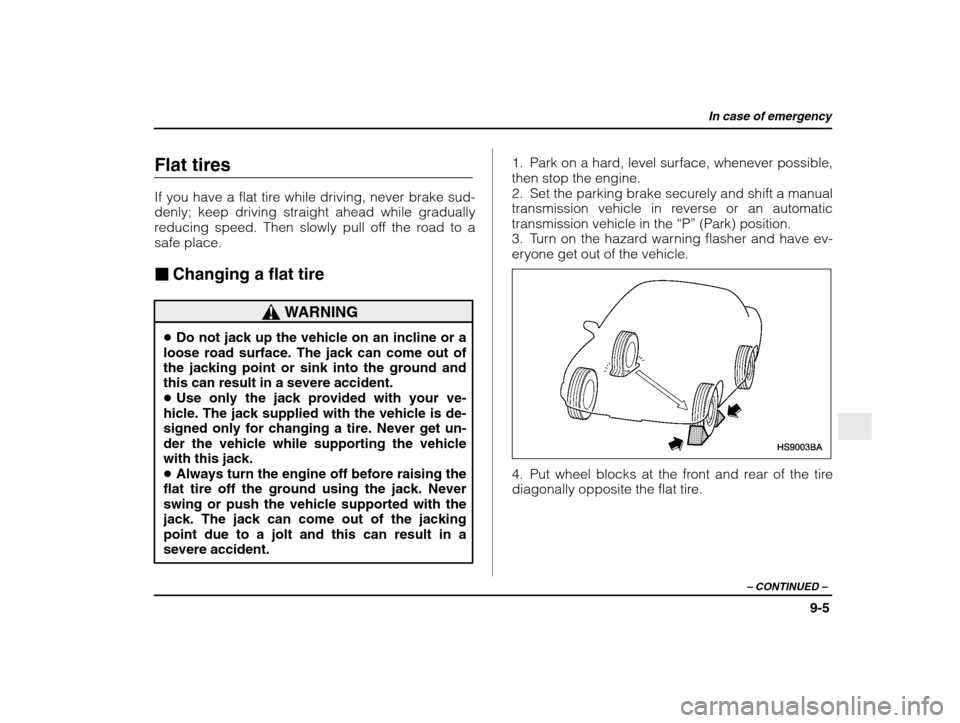2003 SUBARU IMPREZA tires
[x] Cancel search: tiresPage 270 of 425

Driving tips
8-17
– CONTINUED –
The load capacity of your vehicle is determined by
weight, not by available cargo space. The maximum
load you can carry in your vehicle is shown as the
Vehicle Capacity Weight on the tire information label
attached to the driver ’s side door jamb. It includes
the total weight of driver and all passengers andtheir belongings, any optional equipment such as a
trailer hitch, roof rack or bike carrier, etc., and the
tongue load of a trailer.
The tire information label also shows recommended
tire inflation pressure under full loading and trailer
towing conditions. Adjust tire inflation pressures
according to the loading conditions. For the tire inflation pressures, refer to the
“Tires and wheel ”
section in Chapter 11. � GVWR and GAWR (Gross Vehicle
Weight Rating and Gross Axle WeightRating)
The certification plate attached to the driver ’s side
door jamb shows GVWR (Gross Vehicle Weight Rat-
ing) and GAWR (Gross Axle Weight Rating).
The GVW (Gross Vehicle Weight) must never ex- ceed the GVWR. GVW is the combined total of
weight of the vehicle, fuel, driver, all passengers,
luggage, any optional equipment and trailer tongue
Page 271 of 425

Driving tips
8-18
load. Therefore, the GVW changes depending on
the situation. The GVWR equals Curb Weight (actualweight of your vehicle – including standard equip-
ment, fluids, emergency tools and spare tire assem-bly) plus the vehicle capacity weight. In addition, the total weight applied to each axle
(GAW) must never exceed the GAWR. The front and
rear GAWs can be adjusted by relocating luggageinside the vehicle.Even if the total weight of your luggage is lower than
the vehicle capacity weight, either front or rear GAW
may exceed the GAWR, depending on the distribu-
tion of the luggage.
If you carry heavy loads in the vehicle, you should
confirm that GVW and front and rear GAWs are with-
in the GVWR and GAWR by putting your vehicle on
a vehicle scale, found at a commercial weighing sta- tion.
Do not use replacement tires with a lower load range than the originals because they may lower the
GVWR and GAWR limitations. Replacement tireswith a higher load range than the originals do not in-
crease the GVWR and GAWR limitations. �
Roof rail and crossbar (if equipped)
1) Crossbar kit
The roof rail is not designed to carry cargo by itself.
Cargo can be carried after securing the roof cross-
bar kit to the roof rail and installing the appropriate
carrying attachment. When installing the roof cross-
bar kit, follow the manufacturer ’s instructions.
When you carry cargo on the roof using the roof
crossbar kit and a carrying attachment, never ex-
ceed the maximum load limit explained below. You
should also be careful that your vehicle does not ex-
ceed the Gross Vehicle Weight Rating (GVWR) and
Page 280 of 425

Driving tips
8-27
– CONTINUED –
Trailer towing
Your car is designed and intended to be used pri-
marily as a passenger-carrying vehicle. Towing a
trailer puts additional loads on your car ’s engine, dri-
vetrain, brakes, tires and suspension and has an
adverse effect on fuel economy.
If you do decide to tow a trailer, your safety and sat-
isfaction depend upon proper use of correct equip-
ment and cautious operation of your vehicle. Seekthe advice of your SUBARU dealer to assist you in
purchasing a hitch and other necessary towing
equipment appropriate for your vehicle. In addition,
be sure to follow the instructions on correct installa-
tion and use provided by the trailer and other towing
equipment manufacturers.
SUBARU assumes no responsibility for injuries or
vehicle damage that result from trailer towing equip-
ment, or from any errors or omissions in the instruc- tions accompanying such equipment or for your fail-
ure to follow the proper instructions. � Warranties and maintenance
SUBARU warranties do not apply to vehicle damage or malfunction caused by trailer towing. If you use
your vehicle to tow a trailer, more frequent mainte-
nance will be required due to the additional load. (Refer to
“Maintenance schedule under severe driv-
ing conditions ” in the “Warranty and Maintenance
Booklet”.)
Under no circumstances should a trailer be towedwith a new vehicle or a vehicle with any new power-
train component (engine, transmission, differential, wheel bearings, etc.) for the first 1,000 miles (1,600 km) of driving. � Maximum load limits
WARNING
Never exceed the maximum load limits ex-
plained below. Exceeding the maximum loadlimits could cause personal injury and/or ve-hicle damage.
CAUTION
�Adequate size trailer brakes are required
when the trailer and its cargo exceed 1,000 lbs (453 kg) total weight. � Before towing a trailer, check the trailer total
weight, GVW, GAWs and tongue load. Make sure the load and its distribution in your
vehicle and trailer are acceptable.
Page 286 of 425

Driving tips
8-33
– CONTINUED –
CAUTION
�Do not modify the vehicle exhaust system,
brake system, or other systems when instal- ling a hitch or other trailer towing equipment. � Do not use axle-mounted hitches as they
can cause damage to the axle housing, wheelbearings, wheels or tires.
� WAGON including OUTBACK SPORT
The use of a genuine SUBARU trailer hitch is recom-
mended. A genuine SUBARU hitch is available from
your SUBARU dealer.
If use of a non-genuine hitch is unavoidable, be sure
the hitch is suited to your vehicle and trailer. Consult
with a professional hitch supplier to assist you in
choosing an appropriate hitch for your vehicle. Be
sure to follow all of the hitch manufacturer ’s instruc-
tions for installation and use.
Never use a hitch that mounts only to the rear bum-
per. The bumper is not designed to handle that typeof load.
For all types of hitches, regularly check that the
hitch mounting bolts and nuts are tight.
� SEDAN
SUBARU does not offer accessory trailer hitches. Consult with a professional hitch supplier to assist
you in choosing an appropriate hitch for your ve-
hicle. Be sure to follow all of the hitch manufacturer
’s
instructions for installation and use.
Never use a hitch that mounts only to the rear bum-
per. The bumper is not designed to handle that type of load. Regularly check that the hitch mounting bolts and
nuts are tight.
� Connecting a trailer
� Trailer brakes
If your trailer ’s total weight (trailer weight plus its
cargo weight) exceeds 1,000 lbs (453 kg), the trailer
is required to be equipped with its own brake sys-
tem. Electric brakes or surge brakes are recom-
mended, and must be installed properly. Check thatyour trailer ’s brakes conform with Federal, state/
province and/or other applicable regulations. Your
SUBARU’ s brake system is not designed to be
tapped into the trailer ’s hydraulic brake system.
Please ask your SUBARU dealer and professional
trailer supplier for more information about the trail-er’ s brake system.
Page 288 of 425

Driving tips
8-35
– CONTINUED –
eral, state/province and/or other applicable regula- tions.
� Trailer lights
Connection of trailer lights to your vehicle ’s electrical
system requires modifications to the vehicle ’s light-
ing circuit to increase its capacity and accommo-
date wiring changes. To ensure the trailer lights are
connected properly, please consult your SUBARU
dealer. Check for proper operation of the turn sig-nals, the brake lights and parking lights each timeyou hitch up.
CAUTION
Direct splicing or other improper connection
of trailer lights may damage your vehicle ’s
electrical system and cause a malfunction ofyour vehicle ’s lighting system.
� Tires
Make sure that all the tires on your vehicle are prop-
erly inflated to the pressure specified on the tire
placard located on the left center pillar of your ve-hicle.
Trailer tire condition, size, load rating and proper
inflation pressure should be in accordance with the trailer manufacturer
’s specifications.
In the event your vehicle gets a flat tire when towing
a trailer, ask a commercial road service to repair the
flat tire.
If you carry a regular size spare tire in your vehicle
or trailer as a precaution against getting a flat tire,
be sure that the spare tire is firmly secured.
WARNING
Never tow a trailer when the temporary spare tire is used. The temporary spare tire is not
designed to sustain the towing load. Use ofthe temporary spare tire when towing canresult in failure of the spare tire and/or less
stability of the vehicle.
� Trailer towing tips
CAUTION
�Never exceed 45 mph (72 km/h) when tow-
ing a trailer in hilly country on hot days. � When towing a trailer, steering, stability,
stopping distance and braking performancewill be different from normal operation. For
Page 292 of 425

9
9-1
– CONTINUED –
If you park your vehicle in case of
an emergency 9-2 . . . . . . . . . . . . . . . . . . . . . . . . . . . . . . . . . . . . . .
Temporary spare tire (if equipped) 9-3 . . . . . . . . . . . .
Flat tires 9-5
. . . . . . . . . . . . . . . . . . . . . . . . . . . . . . . . . . . . . . . . . . . . . . . .
Changing a flat tire 9-5 . . . . . . . . . . . . . . . . . . . . . . . . . . . . . . . .
Jump starting 9-14 . . . . . . . . . . . . . . . . . . . . . . . . . . . . . . . . . . . . . . . .
How to jump start 9-15 . . . . . . . . . . . . . . . . . . . . . . . . . . . . . . . . . .
Engine overheating 9-17 . . . . . . . . . . . . . . . . . . . . . . . . . . . . . . . .
If steam is coming from the engine compartment 9-17 . . . . . . . . . . . . . . . . . . . . . . . . . . . . . . . . . . . . .
If no steam is coming from the engine compartment 9-17 . . . . . . . . . . . . . . . . . . . . . . . . . . . . . . . . . . . . .
Towing 9-18
. . . . . . . . . . . . . . . . . . . . . . . . . . . . . . . . . . . . . . . . . . . . . . . . . .
Towing and tie-down hooks 9-19 . . . . . . . . . . . . . . . . . . . . .
Using a flat-bed truck 9-21 . . . . . . . . . . . . . . . . . . . . . . . . . . . . .
Towing with all wheels on the ground 9-22 . . . . . . . . .
Maintenance tools 9-23 . . . . . . . . . . . . . . . . . . . . . . . . . . . . . . . . . .
Jack and jack handle 9-24 . . . . . . . . . . . . . . . . . . . . . . . . . . . . .
In case of emergency
Page 294 of 425

In case of emergency
9-3
– CONTINUED –
Temporary spare tire (if equipped)
The temporary spare tire is smaller and lighter than
a conventional tire and is designed for emergency
use only. Remove the temporary spare tire and re-
install the conventional tire as soon as possible be-
cause the spare tire is designed only for temporary use.
Check the inflation pressure of the temporary spare
tire periodically to keep the tire ready for use. The
correct pressure is 60 psi (4.2 kg/cm2
, 420 kPa) .
When using the temporary spare tire, note the fol-lowing:� Do not exceed 50 mph (80 km/h).
� Do not put a tire chain on the temporary spare tire.
Because of the smaller tire size, a tire chain will not
fit properly. � Do not use two or more temporary spare tires at
the same time. � Do not drive over obstacles. This tire has a smaller
diameter, so road clearance is reduced.
1) Tread wear indicator bar
2) Indicator location mark
� When the wear indicator appears on the tread, re-
place the tire.
Page 296 of 425

In case of emergency
9-5
– CONTINUED –
Flat tires
If you have a flat tire while driving, never brake sud- denly; keep driving straight ahead while gradually
reducing speed. Then slowly pull off the road to asafe place. �Changing a flat tire
WARNING
�Do not jack up the vehicle on an incline or a
loose road surface. The jack can come out of
the jacking point or sink into the ground and this can result in a severe accident.� Use only the jack provided with your ve-
hicle. The jack supplied with the vehicle is de-signed only for changing a tire. Never get un-der the vehicle while supporting the vehicle with this jack. � Always turn the engine off before raising the
flat tire off the ground using the jack. Neverswing or push the vehicle supported with the
jack. The jack can come out of the jackingpoint due to a jolt and this can result in a
severe accident. 1. Park on a hard, level surface, whenever possible,
then stop the engine.
2. Set the parking brake securely and shift a manual
transmission vehicle in reverse or an automatictransmission vehicle in the
“P” (Park) position.
3. Turn on the hazard warning flasher and have ev-
eryone get out of the vehicle.
4. Put wheel blocks at the front and rear of the tire
diagonally opposite the flat tire.